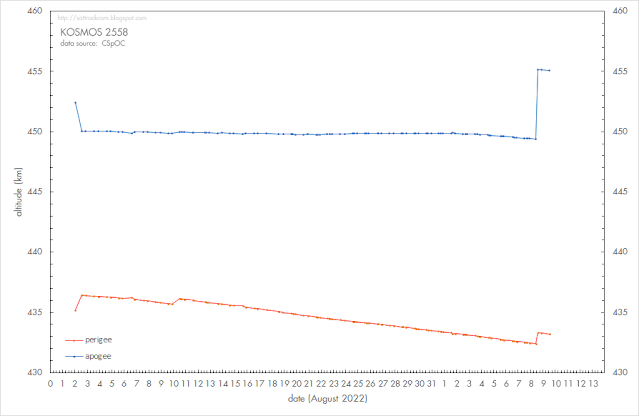[updated 9 Sept 2022 20:00 UTC]
In a series of previous blogposts (here, here and here) I wrote about a cat-and-mouse game going on in space, where the recently launched Russian satellite Kosmos 2558 (2022-089A) is stalking the US spy satellite USA 326 (2022-009A).
That game of cat-and-mouse is still ongoing. Over the past week, Kosmos 2558 has been making adjustments to its orbital inclination (see the diagram above).
At first glance, you would say that it is apparently moving its orbit away from USA 326, as it is increasing the difference in orbital inclination.
But that is deceptive. The difference in orbital inclination between the two objects is actually very small (currently 0.2 degrees), and so is the difference in RAAN (currently 0.26 degrees). The two objects basically share the same orbital plane.
So why the adjustments in orbital inclination? If you look at the diagram below, which depicts the effects of the orbital inclination adjustments on the precession of the RAAN (i.e. the drift of the node of the orbit), you will note that the effect is that the RAAN precession starts to more closely match that of USA 326.
In other words: the adjustment is actually in order to get the precession of the two orbital planes synchronised, i.e. to make sure the orbital planes do not drift too far apart. This ensures that the two objects will continue to share virtually the same orbital plane.
 | |
| Click diagrams to enlarge | |
Because Kosmos 2558, while sharing the same orbital plane as USA 326, is orbiting at a slightly lower orbital altitude than USA 326 (on average some 60 km lower), its orbital inclination needs to be slightly different from that of USA 326 in order to maintain a similar RAAN precession: the rate of RAAN precession depends on both the inclination and orbital altitude.
The fact that it is making adjustments to synchronize its rate of RAAN precession with that of USA 326, again makes clear that the launch of Kosmos 2558 into the orbital plane of USA 326 is no coincidence.
The image below shows how closely the orbital planes match: the main difference is a relatively small difference in altitude. This results in slightly different orbital periods for both satellites, and as a result Kosmos 2558 is 'taking over' USA 326 every 5 days, resulting in flyby's at distances of 60 to 80 km each 5 days.
 |
| click image to enlarge |
UPDATE 9 Sept 2022 20:00 UTC:
Kosmos 2558 made an orbit raising manoeuvre on 8 September 2022 around 11:10 UTC, raising apogee by 5.5 km and perigee by 1 km. It also adjusted its orbital inclination again, to get the RAAN precession closer to that of USA 329:
 |
| click diagram to enlarge |
 |
| click diagram to enlarge |

Thanks, really interesting insights and observations! RAAN is one of the things you don't learn when playing KSP ;-)
ReplyDeleteRAAN precession, of course.
ReplyDelete